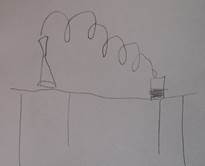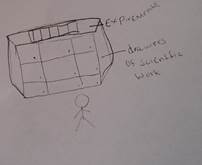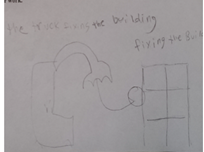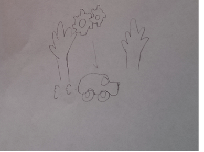 |
December 2016
|
December 2016 // Volume 54 // Number 6 // Research In Brief // v54-6rb8
Economically Disadvantaged Minority Girls' Knowledge and Perceptions of Science and Engineering and Related Careers
Abstract
This article addresses economically disadvantaged minority girls' knowledge and perceptions of science and engineering and the influence of their experiences with science, technology, engineering, and mathematics (STEM) on their choices for future careers. We interviewed three girls who participated in a 4-H–led gender-inclusive STEM program. Our findings suggest that the girls lacked opportunities to learn STEM in out-of-school settings and that they had very limited knowledge about STEM professions. They did not associate their job aspirations as being related to STEM, even though they were. To better prepare such girls to engage in STEM, educators need to provide long-term interventions that are supported by both out-of-school programs and families.
Background
Historically, women and minorities have been underrepresented in science, technology, engineering, and mathematics (STEM) occupations (Burke, 2007). A research report by the American Association of University Women (Hill, Corbett, & St. Rose, 2010) stated that stereotypes, social beliefs, and gender disparity at the hiring stage may be the major causes hindering the progress of closing the gender gap related to STEM degrees and STEM in the workplace. Several studies have shown that the main reason young women and girls lack interest in pursuing certain STEM majors is the perception that the relevant fields are for males (Cheryan, Plaut, Davies, & Steele, 2009; Furnham, Reeves, & Budhani, 2002; Sadker & Sadker, 1994; Walton & Cohen, 2007). Furthermore, these studies have suggested that girls' lack of interest in pursuing STEM majors or STEM-related careers is affected not only by the threat of the stereotype they perceive exists in society but also by their own images of scientists and engineers.
It is important to reach girls early with efforts to increase their interest in STEM. The attitudes of girls toward science become increasingly negative with age (Baram-Tsabari, Sethi, Bry, & Yarden, 2006; Sadler, Sonnert, Hazari, & Tai, 2012). If girls do not expect to succeed in STEM domains as early as elementary-school age, it is not surprising that their interests have shifted to fields in which they feel more comfortable later in their academic careers.
In the study reported here, a program involving bicycles was designed and implemented with help from 4-H educators to address the Minnesota 4-H STEM initiative. The program targeted fifth-grade girls. The multipart research question that guided the study was this: What is the extent of fifth-grade minority girls' knowledge about scientists and engineers, what are their perceptions of science and engineering, and how have their STEM interests influenced their choices for future careers?
Method
Our study was qualitative in nature. We employed an interpretive multicase study design (Yin, 2003) to conduct an in-depth investigation of three female fifth graders' views of STEM fields.
Setting
The study was conducted within the workings of a nonprofit organization that serves a high-need, inner-city neighborhood. In 2011, due to an elevated high school drop-out rate, the organization realized that girls in the community urgently needed a program that could help them build self-esteem. In 2012, with help from the community, the organization opened a bicycle shop to engage youth apprentice mechanics and build skills and experience in customer service. Yet the organization recognized the remaining need for a program designed to afford girls living in the community a learning experience that integrated science and engineering with explicit gender-equity instruction. Members of the organization and community believed that STEM education delivered via gender-equity instruction would not only increase the girls' STEM knowledge but also enhance their self-esteem. Therefore, they sought assistance from Minnesota 4-H to codevelop and implement the Pedal Power program because Minnesota 4-H was recognized by those concerned as providing exciting, interactive learning experiences that engage youths in learning STEM.
Program Design
The Pedal Power program included not only STEM content—physics, mechanical engineering, and mathematics related to bicycles—but also youth development components, such as a focus on positive body image, explicit gender-equity instruction, and promotion of self-esteem. The girls attended the program once a week for 6 weeks; each session was 4 hr. Three female instructors (a STEM specialist from 4-H, a bicycle mechanic, and a youth development specialist) developed and delivered the program together. In each session, the girls worked with all three instructors. The STEM content for the 6-week program is presented in Table 1.
| Date | Lesson |
| Day 1 |
Kick-off Event
|
| Day 2 |
Levers and Breaks
|
| Day 3 |
Wheel and Axle
|
| Day 4 |
The Engineering Design Challenge
|
| Day 5 |
Working on the Bicycle
|
| Day 6 |
Field Trip
|
The Pedal Power program was designed to help girls practice STEM knowledge in a real-world context. For example, one activity addressed the roles of engineers and scientists. In it the girls used everyday tools, hair clips and bobby pins, to help them understand how the tools had been engineered as solutions to a problem, much like other materials, structures, or systems (Wang, Billington, & Chen, 2014). The girls scrutinized the different designs and functions of the clips and pins. The instructor provided pictures of different hairstyles and asked the girls to practice the scientific skills of prediction, observation, and explanation. After making predictions, the girls tried to use the tools to create certain hairstyles with their partners. At the end of the activity, the instructor asked the girls to explain why each hair accessory had a particular design and to predict what other tools could be used to make other styles. The activity was designed on the 4-H learn-by-doing model and was intended to teach the girls about problem solving, decision making, coping, and communicating.
Participants
Three fifth grade girls—"Mabel," "Kelly," and "Melissa" (all pseudonyms)—participated in our study. These girls were selected on the basis of two factors: (a) their complete attendance during the program and (b) our ability to acquire parental permission for participation. They all lived close to the bike shop and were able to attend the program easily. Before the program, the girls participated in a short, nonformal interview in which they described their personalities, personal strengths, areas for growth, and possible future careers.
In her preprogram interview, Mabel described herself as Asian American. She characterized herself as an indoor person and said she wanted to become more active in her everyday life. She felt that she was not doing well in school, and she wanted to make some changes to improve her school performance. As for her career aspirations, Mabel reported wanting to become a photographer because one of her family members was a photographer. She did not believe that she would go to college.
The second participant, Kelly, described herself as African American. She spoke confidently about herself, indicating that she believed herself to be talented, pretty, and smart and able to play basketball as well as boys. She felt that there was nothing she should do to improve herself. She also said she was doing particularly well in mathematics in school. Kelly reported wanting to become a nurse, a pediatrician, or a teacher.
Melissa, the third participant, described herself as African American. Melissa, who is Kelly's cousin, likened her traits to Kelly's: talented, pretty, and smart. Melissa reported that she loves dancing and singing and that she is good at both. Like Kelly, Melissa felt that there was nothing she should do to improve herself. She acknowledged that she did not particularly like mathematics but viewed it as an important subject. She also reported feeling that she should do well in school. Like her cousin Kelly, Melissa said she wanted to become a nurse or a doctor.
Data Collection
We used two data sources in the study: (a) preprogram and postprogram semistructured interviews and (b) preprogram and postprogram Draw-a-Scientist Test (Chambers, 1983) and Draw-an-Engineer-Test (Carr & Diefes-Dux, 2012) activities.
Data Analysis
The data analysis procedures consisted of (a) open coding (Strauss & Corbin, 1990), (b) identification of patterns for each case, and (c) identification of themes across the cases (LeCompte & Preissle, 1993). To avoid research-question bias, we used various interview questions to try to elicit the girls' knowledge about scientists and engineers, their perceptions of science and engineering, and information about how the girls' knowledge about scientists and engineers and their interests influenced their choices for potential careers. We conducted an extensive literature review to select our interview questions from existing surveys. We selected and modified our interview questions on the basis of items from the Upper Elementary School Student Attitudes Toward STEM Survey (Faber, 2013). We pilot tested the interview questions with three students to ensure the validity and reliability of the questions.
Results
Girls' Perceptions of Science and Engineering Experiences
When the three girls were asked to give examples of science and engineering in their everyday lives, all three gave examples involving science in school. It is important to note that Mabel and Kelly both elaborated on their school science experiences by suggesting that when they worked as a team to do science activities at school, they did not like teaming with boys. In addition to school science, they considered TV shows they had watched to be examples of science experiences in their everyday lives. As for engineering activities, none of the girls could give an example from her everyday life that was related to engineering prior to the program. Even after the Pedal Power program, the examples the girls gave as their everyday life experiences with engineering were mostly related to fixing bikes or using tools.
Girls' Views of Scientists and Engineers
Overall, experiment was the key word the girls associated with science both before and after the program. As noted, before the program the girls could not give examples of engineering in their everyday lives. Their drawings indicated that they perceived engineering as being related to tools, houses, and cars. See Figures 1 and 2 for examples. Overall, fixing and building were the key words the girls associated with engineering both before and after the program. The word invention also was used by Melissa to describe engineering.
Figure 1.
Mabel's Preprogram and Postprogram Portraits of Scientists
(Preprogram Portrait on Left, Postprogram Portrait on Right)


Figure 2.
Mabel's Preprogram and Postprogram Portraits of Engineers
(Preprogram Portrait on Left, Postprogram Portrait on Right)


From before the program to after the program, Mabel and Kelly changed their perceptions of who could become a scientist or an engineer. Both girls had started to perceive that gender was not an issue and that girls could become scientists or engineers. In addition, the girls believed that scientists and engineers are smart people who are good at both science and mathematics. Mabel believed that to become a scientist or an engineer, a person needed to go to college. Before the program, she did not think she could become a scientist or an engineer because her grades were not good enough for college. After the Pedal Power program, Mabel felt that because she knew how to fix a bike, she might be able to become an engineer.
Family as an Influential Factor on Girls' Interest in STEM
Before the Pedal Power program, the girls talked about science they did at school as examples of their everyday science experiences. They believed that performing experiments was the major task scientists do in their jobs. As for engineering, they could not give any concrete examples before the program. After the program, they began to see that engineers invent things to help people; however, their thoughts remained stuck on fixing and building as major tasks that engineers do in their jobs. In addition, their career choices were influenced by their family values and family experiences. The girls felt that they had already chosen their preferred future careers, and they believed that their choices did not involve science or engineering. Mabel wanted to be a photographer, like her aunt. Kelly, influenced by the television programs she watched with her mother, wanted to work in a medical-related career. Melissa also wanted to work in a medical-related career, like Kelly, her cousin. Although working in medical-related careers involves certain levels of science, the girls did not see this connection.
Lack of Recognition of Scientific Skills as Components of Science and Engineering
Although during each day of the program, the girls practiced making a prediction, making an observation, and explaining, all three girls felt that they had learned something new in the program but had a hard time explaining the scientific skills they learned and practiced through the activities. The only activity they viewed as science was one that involved running various trials with Lego cars having different wheels to test distance traveled. Also, all three girls indicated that building simple Lego machines, testing the Lego cars, and doing other activities at the bicycle shop were examples of engineering activities.
Discussion and Implications
It is important to note that the study participants, who were economically disadvantaged minority young girls, did not have many resources for experiencing science and engineering outside school. Also, the research has limitations in terms of generalizability due to the small sample size.
Some of the major findings of the study may have implications related to economically disadvantaged minority young girls:
- Because girls have fewer extracurricular STEM experiences than boys (Jones, Howe, & Rua, 2000), the science and engineering experiences that economically disadvantaged minority young girls have at school very likely become what they perceive to be science and engineering and have a critical influence on their interests in STEM education. Therefore, it is important to provide opportunities outside school that help economically disadvantaged minority girls learn science and engineering.
- It may help elementary-age girls learn if educators avoid mixed-gender groups when teaming youths to do STEM activities.
- Deep-rooted, naïve conceptions of scientists and engineers can blur girls' interpretations of STEM careers, preventing them from having broader understandings of science and engineering. We believe that to address this issue, girls need more opportunities that expose them to various science and engineering experiences, particularly in out-of-school environments.
- Many youth programs lack necessary role models for minority youths (Alston & Crutchfield, 2009; Cano & Bankston, 1993). Consequently, families play an important role in encouraging minority youths to explore STEM career options.
- A short-term program likely is not enough to change girls' naïve conceptions of scientists and engineers, reverse their misconceptions about science and engineering, or increase their interest in pursuing STEM careers.
To successfully turn the tide and better prepare economically disadvantaged minority young girls to engage in STEM, we need long-term intervention that is supported by schools, families, and other entities. Therefore, as Ward and Webster (2011) suggested, professionals in youth development organizations, such as 4-H, need to seek out long-term relationships with communities to provide minority youths with more out-of-school learning experiences. In addition, 4-H educators should take the lead in applying concepts of gender-equity instruction, such as avoiding mixed-gender instruction, when teaching STEM to economically disadvantaged minority young girls.
References
Alston, A. J., & Crutchfield, C. M. (2009). A descriptive analysis of the perceptions of North Carolina 4-H agents toward minority youth participation in agricultural-related activities. Journal of Extension, 47(5) Article 5RIB5. Available at: http://www.joe.org/joe/2009october/rb5.php
Baram-Tsabari, A., Sethi, R. J., Bry, L., Yarden, A. (2006). Using questions sent to an ask-a-scientist site to identify children's interests in science. Science Education, 90, 1050–1072.
Burke, R. J. (2007). Women and minorities in STEM: A primer. In R. J. Burke & M. C. Mattis (Eds.), Women and minorities in science, technology, engineering and mathematics: Upping the numbers. Northampton, MA: Edward Elgar Publishing.
Cano, J., & Bankston, J. (1993). Involving minority youth in 4-H. Journal of Extension, 33(1) Article 1RIB4. Available at: http://www.joe.org/joe/1993spring/rb4.php
Carr, R. L., & Diefes-Dux, H. A. (2012). Change in elementary student conceptions of engineering following an intervention as seen from the Draw-an-Engineer Test. Proceeding of the American Society for Engineering Education, San Antonio, TX.
Chambers, D. W. (1983). Stereotypic images of the scientist: The Draw-a-Scientist Test. Science Education, 67(2), 255–265.
Cheryan, S., Plaut, V. C., Davies, P. G., & Steele, C. M. (2009). Ambient belonging: How stereotypical cues impact gender participation in computer science. Journal of Personality and Social Psychology, 97, 1045–1060.
Faber, M. (2013). Student attitudes toward STEM: The development of upper elementary school and middle/high school student surveys. Retrieved from file:///C:/Users/huiwang/Downloads/GLFSTEM-ASEE13-ERM-Final.pdf
Furnham, A., Reeves, E., & Budhani, S. (2002). Parents think their sons are brighter than their daughters: Sex differences in parental self-estimations and estimations of their children's multiple intelligences. Journal of Genetic Psychology, 163, 24–39.
Hill, C., Corbett, C., & St. Rose, A. (2010). Why so few? Women in science, technology, engineering and mathematics. Washington DC: American Association of University Women.
Jones, G. M., Howe, A., & Rua, M. J. (2000). Gender differences in students' experiences, interests, and attitudes toward science and scientists. Science Education, 84(2), 180–192.
LeCompte, M. D., & Preissle, J. (1993). Ethnography and qualitative design in educational research (2nd ed.). San Diego, CA: Academic Press.
Sadker, M., & Sadker, D. (1994). Failing at fairness: How America's schools short change girls. New York, NY: Touchstone.
Sadler, P. M., Sonnert, G., Hazari, Z., & Tai, R. (2012). Stability and volatility of STEM career interest in high school: A gender study. Science Education, 96(3), 411–427.
Strauss, A., & Corbin, J. (1990). Basics of qualitative research: Grounded theory procedures and techniques. Newbury Park, CA: Sage Publications, Inc.
Walton, G. M., & Cohen, H. (2007). A question of fit: Race, social fit, and achievement. Journal of Personality and Social Psychology, 92, 82–96.
Ward, S., & Webster, N. (2011). Cultural relevance and working with inner city youth populations to achieve civic engagement. Journal of Extension, 49(5) Article 5TOT5. Available at: http://www.joe.org/joe/2011october/tt5.php
Wang, H. H., Billington, B. L., & Chen, Y. C. (2014). STEM in a hair accessory. Science and Children, 52(3), 54–59.
Yin, R. K. (2003). Case study research: Design and methods, (3rd ed.). London, UK: Sage.




